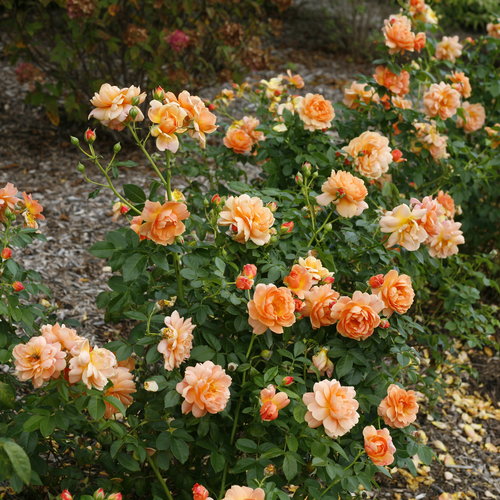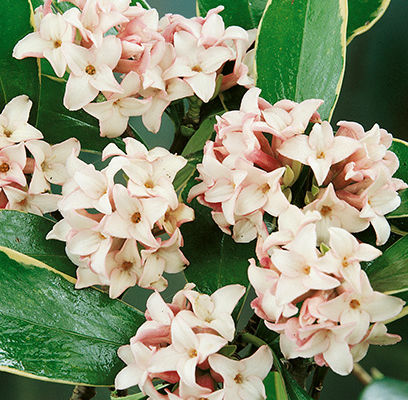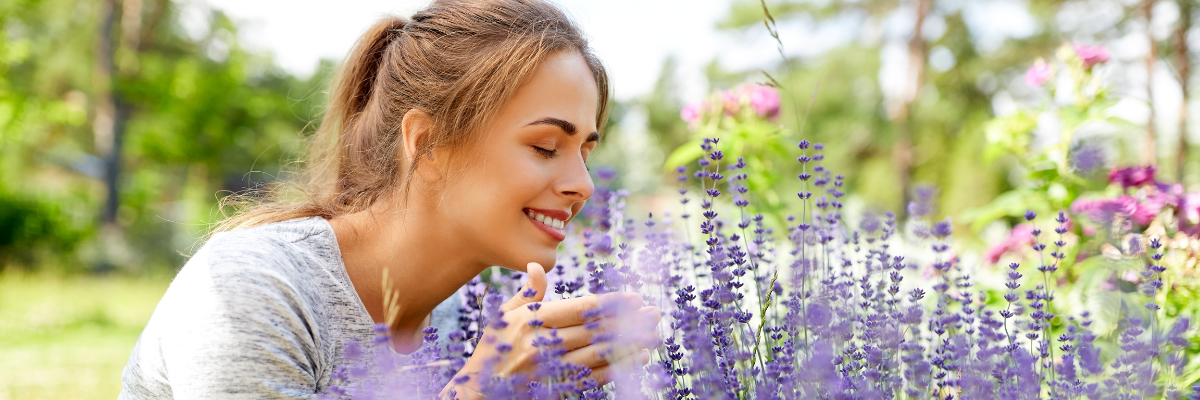What’s your favorite garden memory?
Is it burying your nose in sweet lavender lilacs, sneaking a sip of nectar from fragrant honeysuckle as a child, snipping spicy roses for a bouquet, or harvesting piney rosemary for recipes?
Whatever your memories evoke, they’re sure to be tied to scent. After all, smell, emotion, and memories are closely linked, due to the brain’s anatomy. And while choosing plants based on color scheme or texture may be at the forefront of your mind when plant shopping, selecting deliciously fragrant plants adds a whole new dimension to your garden design.
When selecting plants for a fragrance garden, you’ll find spectacularly scented shrubs, perennials, bulbs, annuals, and—of course—herbs. Before you begin shopping, take a moment to plan your garden, choosing fragrant plants that bloom at different times throughout the year for a succession of scent through the seasons. You’ll enjoy sweet scents all season long with a little planning.
When choosing plants for a fragrance garden, remember that while fragrant flowers add sweet scent to a garden, the foliage of many plants provides fabulous fragrance, too. Run your fingers through a rosemary hedge, crush a citronella leaf, rub the leaves of a mint plant, or even walk on creeping thyme and relish a boost of aromatherapy.
Superior Shrubs for Scent
From privacy hedges to foundation plantings to spectacular specimens, shrubs are garden workhorses. But when you look beyond the foliage and select shrubs for fabulous fragrance, they become gorgeous design elements that delight the sense of smell. Why choose a shrub just for foliage when you can enjoy the sweet aroma of fragrant flowers, too?
Choose a few of these classic fragrant favorites for your garden.
Roses

“A rose by any other name would smell as sweet.”
Shakespeare certainly wasn’t the first person to immortalize the fabulous fragrance of roses, and gardeners throughout the centuries adore adding these aromatic beauties to their landscapes—and vases. For a while, as breeders worked to create disease-resistant roses, fragrance took a back seat to healthy foliage. Luckily, today’s roses combine the best of both worlds: good disease resistance with delicious, old-world scent. Look for varieties like citrus-scented California Dreamin’ Hybrid Tea Rose, the peony-shaped blooms scented with hints of apple and champagne of Parfuma® Earth Angel, or the dark red, sweetly scented Brindabella Crimson Knight rose. Truly, you’ll find hundreds of beautifully fragrant varieties to grow.
Gardenia

Nothing says old-world elegance like the scent of gardenias.
During the Gilded Age, gentlemen wore gardenia boutonnieres, and the scent of gardenias famously floats through southern yards, as gardeners sip sweet tea on porches. For an early, double variety with 4- to 5-inch blooms that continue throughout the growing season, try First Love®. While many gardenias balk at temperatures outside of zones 8-11, Fool Proof™ tolerates the cooler climate of zone 7. If space is an issue, you’ll love the compact, mounding Buttons gardenia. Only 2 feet tall and 3 feet wide, the reblooming beauty makes a terrific addition to containers.
Daphne

Before the sweet scents of summer fill the air, daphne delights gardeners with beautiful, delicate blooms that perfume the late winter/early spring garden.
Lovely in landscapes, many daphne varieties perform well in containers for a heavenly-scented patio or porch. Variegated Winter Daphne boasts white blooms with a pink blush and pretty foliage with yellow margins. Eternal Fragrance Daphne produces profuse clusters of blush pink flowers over many months for long-lasting fragrance in the garden. The compact variety works well in urban gardens and containers. The pretty golden variegated foliage of ‘Gold Dust’ Daphne brightens semi-shady gardens and produces highly fragrant pink spring flowers. A compact shrub, it’s ideal for small space gardens.
Lilac

Many gardeners fondly remember fragrant lilac hedges from grandparents’ gardens.
Until recently, only gardeners living in colder zones could recreate those sweet memories. Fortunately, breeders took pity on southern gardeners, creating lilac cultivars that perform beautifully even in warmer climates, such as ‘Josee’, a small, reblooming lilac with the widest hardiness range, growing well in zones 3-9. Plus, while lilacs often battle powdery mildew, newer varieties offer good disease resistance. Compact, mildew-resistant New Age™ Lavender Syringa makes a perfect low-maintenance addition to small gardens. Today’s lilacs also come in a wide range of colors: red, pink, blue, yellow, cream, white, and even picotee. For a compact, reblooming pink variety, try Bloomerang™ Dwarf Pink Lilac. It grows only 2 to 3 feet tall and wide, blooms profusely in spring, and then continues to produce fragrant pink blooms throughout summer.
Sweetbush

A southeastern native that ranges from New York to Florida and west to the Mississippi River region, sweetshrub—also known as Carolina allspice—is a gardener’s dream.
The fragrant blooms smell like citrus, banana, strawberry, pineapple, bubblegum, or even gin, depending on whom you ask, plus the shrub grows beautifully whether planted in full sun or deep shade. Native plant lovers will adore Green Thumb Award winner Sweetshrub Simply Scentsational®, a cultivar hardy in zones 4-9. Deep maroon blooms appear in spring throughout summer, smelling like pineapple or bubblegum. ‘Venus’ produces large shows of clear white, magnolia-like blooms with a banana fragrance in early summer.
Mock orange

An extremely fragrant North American native deciduous shrub for zones 4-7, mock orange produces huge shows of springtime flowers with the scent of orange blossoms.
Traditionally used as a specimen plant or a hedge in the landscape, new cultivars offer a variety of sizes. Illuminati Tower® grows in a columnar habit with a unique 4-sided “tower” effect, producing hundreds of fragrant white flowers in early summer. Reaching only 3 to 4 feet tall and 1.5-feet wide, it’s ideal for narrow spaces. Compact ‘Snow Dwarf’ grows only 2 to 3 feet tall and produces pure white, double flowers with fabulous orange-blossom fragrance, perfect for small gardens.
Viburnum

Beautiful blooms, fabulous fragrance, multi-season interest, and food for wildlife—what’s not to love about viburnum?
With so many varieties available, you’re sure to find the perfect fragrant viburnum for your garden. Sweet Talker® produces hundreds of pink, trumpet-shaped flowers with a spicy, honey scent in late winter/early spring. The plant provides good extended seasonal interest, with the leathery evergreen leaves turning purple-burgundy in fall. With its upright, vigorous growth reaching up to 7 feet tall, ‘Spice Girl’ Koreanspice viburnum makes a gorgeous hedge or specimen plant, with its spicy-sweet pink blooms in mid-spring and bright-red autumn foliage. Or, if space is an issue, choose ‘Baby Spice’, a compact form of its big sister.
Fabulously fragrant perennials
While fragrant shrubs provide good bones for a garden, perennials add joyful color, movement, texture, and—of course—fragrance to beds, containers, and borders. Whether you prefer climbing vines with trumpet-shaped blooms that lure hummingbirds, sweet-smelling flowers perfect for bouquets, or edible herbs that add a burst of aroma to gardens and meals, you’ll find a wide variety of fragrant perennials to add to your garden.Here are 10 different fragrant perennials you will love:
Brugmansia

If you love unique, interesting plants, you’ll love the tropical feel of brugmansia.
Commonly known as Angel’s Trumpet, this exotic, long-lived woody perennial can reach the size of a small tree, depending on the variety, and perfumes the garden with fragrance from its trumpet-shaped blooms. Many brugmansia flowers are especially fragrant on warm summer nights, so place it where you can enjoy the scent. The 6-inch to 24-inch hanging blooms may be white, cream, yellow, peach, orange, pink, or red, depending on the variety. ‘Charles Grimaldi’ is an old-fashioned favorite, with golden blooms that turn orange-salmon when mature. ‘Cypress Gardens’ makes an ideal container plant, with white flowers fading to pale salmon. The blooms are most fragrant in the evening. ‘Inca Sun’ is a hybrid that flowers continuously throughout the summer. All brugmansia need protection from frost, so bring them indoors if you live in a cool climate.
Jasmine

For a fragrant flower that reaches great heights, add Star Jasmine to your garden.
The pretty vine with star-shaped white flowers and dark green foliage looks lovely covering a wall, trellis, or arbor, or use it as a gorgeous groundcover. A tender perennial hardy in zones 8-11, plant it in a container and bring inside in cooler zones. Or for a lovely addition to a moon garden, try Arabian Jasmine. The lush foliage of this vine contrasts beautifully with the intensely fragrant, petite white flowers that open at night and close in the morning, fading to pink as they age.
Honeysuckle

If you garden for wildlife, you’ll love adding honeysuckle to your landscape.
Not only is it intensely fragrant, but pollinators adore the blooms. Plant it where you can savor the scent, and watch hummingbirds enjoy the flowers, too. Scentsation produces lemony-cream flower clusters, contrasting beautifully with the deep-green deciduous foliage. ‘Harlequin’ is a non-invasive, fragrant vine with pink and white flowers against variegated green foliage.
Dianthus

For a burst of early spring beauty and fragrance, dianthus makes a perfect choice.
The pretty, bluish-gray foliage looks lovely against the cheerful, highly scented flowers, which attract pollinators. Commonly known as “pinks,” the name refers to the frilly edges of the petals, which look like they’ve been cut with pinking shears, rather than the color of the flower. In fact, dianthus can be found in a variety of colors, from powder pink to nearly black. ‘Firewitch’ produces vivid violet-rose blooms with a spicy clove scent. Large, showy double pink flowers with white edges adorn Fruit Punch® ‘Raspberry Ruffles’. Scent First™ Raspberry Surprise’s strong stems prevent flopping, while the highly fragrant, double pink and burgundy flowers make a brilliant border with this compact plant.
Tall garden phlox

A classic American perennial, phlox was one of the first North American native plants to enter cultivation.
While there are many types of phlox, tall garden phlox, or Phlox paniculata, makes a popular choice for perennial beds, with its tubular flowers that entice pollinators. Colors range from white, pink, magenta, purple, and blue, and the scented flowers make a sweet addition to your fragrance garden. Newer introductions, like LUMINARY™, provide good vigor and powdery mildew resistance. For a more compact variety that’s good for containers and small spaces, try the Sweet Summer® series–fragrant, early-flowering plants with good disease resistance that reach only 1-1/2 to 2 feet tall.
Lavender

One of the most easily recognizable scents, lavender provides a soothing, calming fragrance that relieves stress and anxiety.
A star in aromatherapy, lavender also looks lovely in well-drained garden beds and containers, plus the flowers add both beauty and fragrance to bouquets. But not all lavenders smell alike: look for some of the most fragrant cultivars for your garden, like Lavandula angustifolia ‘Folgate’ or ‘Hidcote’ or ‘Munstead’. All three varieties are popular among perfumeries. An added benefit to including lavender in your fragrance garden: it’s edible, perfect for your culinary creations.
Peony

For a romantic flower filled with fragrance, peonies belong in your garden.
Although the blooms only last a few weeks, they’re worth it—ruffly, sweetly-scented belles of the ball that makes a stunning appearance in spring then disappear, leaving you wanting more. While some peonies require an up-close sniff to enjoy their scent, others share their fragrance from across the garden. Try ‘Hermione’, ‘Bowl of Beauty’, ‘Henry Bockstoce’, and ‘Duchesse de Nemours’—some of the most fragrant varieties.
Add fragrant plants where you can enjoy them as you walk by or sit to relax: gracing a garden path, welcoming guests near your front door, filling a patio pot, hanging in a windowbox on the balcony, or adorning your favorite garden nook, where you like to escape with a good book. You’ll love the frequent burst of fragrance.
Delightfully Scented Bulbs
From the earliest narcissus to summer-flowering lilies, bulbs offer a long season of fragrance in your garden. But to enjoy the sweet scent of bulbs through the seasons requires a little planning. After all, those intensely-fragrant, summer-blooming Stargazer lilies need to be planted in early spring, while highly-scented hyacinth requires you to think ahead—and plant in fall. Still, the extra effort to add fragrant bulbs to your garden is worth it.Give these bulbs, corms, and tubers a try:
Hyacinth

All varieties of hyacinths are highly fragrant, so it’s an easy decision to add them to your garden.
Pick your favorite colors, then plant them along a walkway, as a front border in flower beds, or in containers. Don’t forget to save a bulb or two to force in the winter for fabulous indoor fragrance.
Freesia

Not only do freesias add delicious fragrance to your garden beds, they look lovely in vases, too.
Available in many colors, all freesias are fragrant, although some gardeners think the single, white varieties offer the most intense scent. Look for ‘Matterhorn’ and ‘Tecotote White’.
Paperwhite Narcissus

Often associated with indoor growing during the holidays, paperwhites create an incredible fragrance in the garden, too.
The pretty white blooms smell delightful even across a garden bed, adding early season scent to your fragrance garden.
Lily

Not all lilies are created equal scent-wise.
While some lilies offer no scent, others exude an overpowering, unpleasant fragrance, so choose lilies wisely. However, the right lilies can add gorgeous perfume to your garden and also look lovely in vases. Look for oriental lilies like ‘Casa Blanca’, ‘Stargazer’, and ‘Dizzy’; orienpets such as ‘Flashpoint’ or ‘Scheherazade’; or species lilies like ‘Album’, Coral Lily, or Golden-Rayed Lily.
Tuberose

Widely considered one of the most fragrant flowers in the world.
Tuberose produces clusters of large, white, or pink blooms on 4-foot tall plants, making them a popular cut flower, too. Add these highly fragrant flowers to perfume your garden—and your bouquets.
Gladiolus

While gladiolus look lovely in the garden, not all are fragrant.
But Gladiolus callianthus ‘Murielae’ — commonly known as Peacock Orchid — adds delightful perfume, as well as beautiful orchid-like white flowers with merlot centers.



Aromatic annuals
Did you suddenly decide to create a fragrance garden—but didn’t plan ahead to order bulbs?
Don’t worry: there are plenty of annuals with intoxicating fragrance you can grow in your garden. You’ll find annuals available at your local garden center, or you can also simply scatter seeds early in the growing season to sow your own fragrant blooms. For an easy, low-maintenance, sweet smelling garden, try annuals like Nicotiana, Sweet Peas, Night-Scented Stock, Sweet Alyssum, or Moonflower.
With so many fabulously fragrant, beautifully blooming choices, you’ll soon fill your fragrance garden with gorgeous, perfectly perfumed flowers. Add a garden bench, and enjoy delightful, homegrown aromatherapy in the garden.

